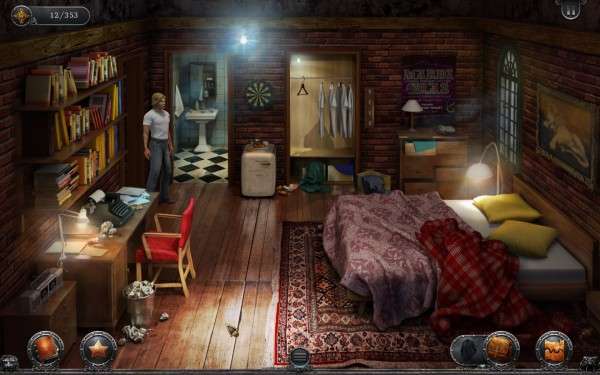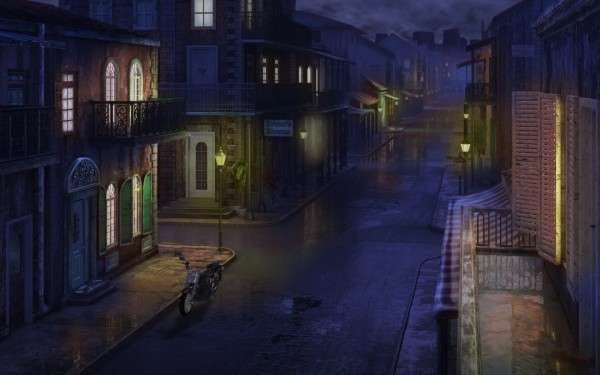
Preview: Gabriel Knight: Sins of The Fathers – 20th Anniversary Edition
Revisiting a game from the past in the form of a remake or a remastered version is always a peculiar prospect. Surely, going back to an old beloved game is not dissimilar to slipping into an old pair of shoes. Part of the appeal is how snugly they fit, how familiar they feel, because you helped shaped them — or perhaps more accurately in the case of a game; it helped shape you.
In the best possible scenario, then, the defining characteristics and the mechanics of a game are sound enough that a remake merely presents them in a more viable guise. The benefit of this being that people who haven’t walked in your shoes – people to whom the low definition art and the bleeps and bloops of the soundtrack have no established context – don’t need a specific nostalgia or niche interest to experience what is still hopefully a faithful representation of the game you loved. But even then, you’re treading on strange ground when you sit someone down in front of it who already has a preconception of what it’s supposed to sound and look like. The original experience’s lack of definition didn’t necessarily mean less definition – the details were there, assigned through imagination, through interpretation.
So, firing up the preview code of Gabriel Knight: Sins of The Fathers certainly meant stepping onto strange ground for me. Gabriel Knight to this day remains not only one of my favourite point-and-click adventure games of all time; it also essentially introduced me to the tropes of the noir genre and its brand of rugged, charming and somewhat out-of-his-depth hero. Needless to say, this remake has a lot to live up to.

The designer and writer of the Gabriel Knight games, Jane Jensen, started family-owned studio Pinkerton Road in 2012 together with composer and husband Robert Holmes, and have since then partnered with Phoenix Online Studios to create the original adventure game Moebius: Empire Rising (reviewed by yours truly), and tackle this remake of Sins of The Fathers. Phoenix Online have been making adventure games for a while, including the stellar Cognition: An Erica Reed Thriller, but if you have been following their output it’s likely that their less-than-stellar tech has become apparent.
That’s why I went into this remake with cautious optimism. Erica of Cognition used to climb furniture and get stuck in the ceiling. Moebius protagonist Malachi Rector’s head would spin into his chest, his shoulders pinch together, and the scale of the locales around him would sometimes be completely off, in one case turning beer into a beverage seemingly served in a shot glass. It’s a relief to discover that Gabriel Knight: Sins of The Fathers is already the most technically and aesthetically sound game that has been powered by Phoenix’ sometimes absurdly elaborate inverse-kinematics based game engine — an engine that usually feels like it’s about to come apart at the seams at any moment.

A quick primer on what this game actually is might be in order. Sins of The Fathers is the first in a line of games about struggling writer Gabriel Knight, who lives in the back of a book store in New Orleans. The store is tended to by his colleague, friend, and basically-secretary, Grace Nakimura. We join the story as voodoo themed murders sweep the city, and thanks to his friend on the police force, Detective Mosely, Gabriel has a leg in on the case in order to gather material for his new book. Things take off proper as a chance meeting occurs between Gabriel and the mysterious and stunning socialite Malia Gedde. Meanwhile, Gabriel himself is plagued by increasingly bizarre and macabre nightmares.
The game was originally released by Sierra-Online in 1993 during what can only be considered the golden age of point-and-click adventure games. Sierra was, pardon the pun, at the peak of their game, and Sins of The Fathers stood its ground beautifully amidst genre greats like Monkey Island 2: LeChuck’s Revenge and Beneath a Steel Sky. Now, 20 years later, the game is revisited by Jane Jensen herself, and a huge part of its revival is obviously a complete overhaul of its visuals and presentation.
Although I’m personally partial to Gabriel Knight’s original Patrick Swayze-esque 80s ‘do, remake-Gabriel’s style is wholly modelled after his romance novel look from the two sequels. In an infinitely more successful attempt than his third outing he is fully polygonal this time, while the backgrounds remain two dimensional. Although it shares some traits with Moebius – that it can’t always decide whether it wants to look hand painted or photo realistic – it thankfully comes together much better than that game’s visuals did. Close ups during dialogue fare worse, however, faces with vacant stares appearing quite unnatural and robotic, both in terms of model work and animation.

The meat of the game is the same. The interface has been streamlined, and there’s an added hint system and a way to highlight points of interaction. Bonus content is also included and contextually activated, such as sketches from the original development of the game, with audio commentary and interviews to be added in as the game continues toward the finish line. It’s interesting to note that some events and puzzle solutions in the game have been moved around slightly, stumping me as to in which order I was carrying out my various tasks. It’s hard to tell whether this was done to keep veterans of the series on their toes, or whether it benefits the pacing of the game. Either way, it’s worth noting.
The preview code ends just as proceedings kick into higher gear. Perhaps more than feeling the excitement and suspense laid out by this iteration of the game, I’m reminded of the excitement I felt playing the original. It is a story and a mystery that truly draws you in, and one that very much delivers in the end as well, giving its various plot threads tremendously satisfying conclusions. It’s a classic, plain and simple – an unmissable experience for fans of the genre. The question that is relevant to me here, however, is whether this is actually a better vessel for that experience.
And while it is too early to tell for sure, I wish I could be much more confident. Though every element of the game is readily recognizable from the original, little of its actual charm feels present. The cast is brand new, bumping people like Tim Curry and Mark Hamill in favour of what I assume are unknowns. Every line uttered by this new Gabriel Knight sounds like a smarmy Forrest Gump reading off script pages, and his flirtatious lines come out sounding creepy rather than charming in a dorky way. I come into this game liking Gabriel by default, but I can’t imagine this iteration of him makes a good first impression on people new to the series.

Most adventure games I’ve played in the last five years – old school adventure games at that, not your Heavy Rains and Walking Deads – run circles around Phoenix Online’s output from a purely technical perspective. Phoenix Online’s strengths has been their writing, their puzzles, and the overarching momentum of their stories. On those merits, it’s possible to brave their otherwise quite wonky presentation, but Gabriel Knight: Sins of The Fathers presents a new situation. In trying to re-contextualise the original story and characters in a new, modern guise, the expectation falls on the updated presentation to make the transformation worth it. The new voice cast should be a better voice cast, not a worse one. The portrayal of the characters should be a more defined and convincing portrayal, not a more robotic and stilted one. This remake doesn’t settle for applying some makeup to ageing sprites, a’ la Monkey Island’s special editions; it attempts to modernise the entire presentation. But with tech and a team that already struggles to appear competitive in that realm with original games, the payoff – at this point – seems dubious at best.
And so it must be approached like a new game, stripped of those expectations, and that is how I intend to approach it when the final product hits my desk. My fingers are crossed that it all comes together in the end, because even when removed from the context of a 1993 release it’s a great story inhabited by great characters. It deserves to be discovered by new fans for whom the blocky visage of the original is too off-putting. If, in addition, it leads into a brand new Gabriel Knight mystery down the line, I’ll be a happy camper. A happy camper in a new pair of old shoes.